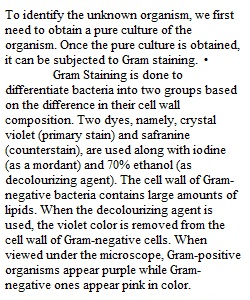


Q Unknown Lab Report- Lab 13 • Points 20 • Submitting a text entry box or a file upload For your Unknown Lab, include the following information: ±Include drawings of your gram-negative unknown bacteria on all three plates: TSA, MacConkey, and EMB. Make sure to describe colony morphology, including color and colony size. ±Draw cell morphology and include cell size ±Write an overview of each biochemical test and what your test results were. ±Prepare a table that includes your observations and interpretations for each test. ±Draw pictures for each test. ±Write a conclusion section that explains your choice and discusses any inconsistent results. ±Research your unknown bacteria and include a paragraph about it. ±Include the summary sheet.
View Related Questions